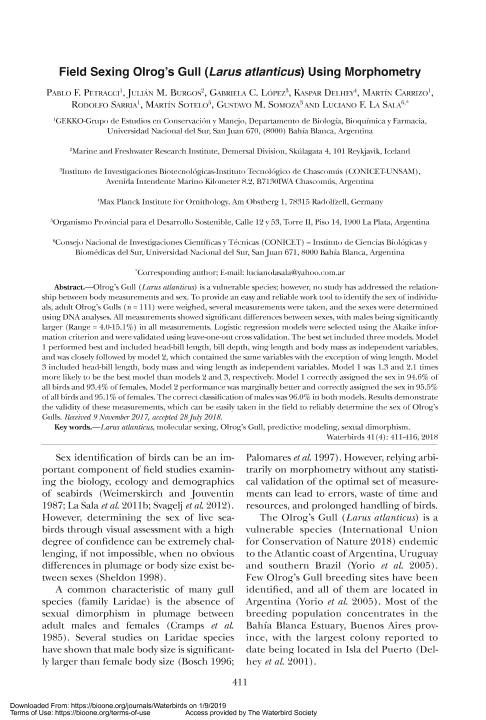Mostrar el registro sencillo del ítem
dc.contributor.author
Petracci, Pablo

dc.contributor.author
Burgos, Julian Mariano

dc.contributor.author
Lopez, Gabriela Carina

dc.contributor.author
Delhey, Kaspar
dc.contributor.author
Carrizo, Martin
dc.contributor.author
Sarria, Rodolfo
dc.contributor.author
Sotelo, Martín
dc.contributor.author
Somoza, Gustavo Manuel

dc.contributor.author
la Sala, Luciano Francisco

dc.date.available
2020-01-14T20:50:45Z
dc.date.issued
2018-12
dc.identifier.citation
Petracci, Pablo; Burgos, Julian Mariano; Lopez, Gabriela Carina; Delhey, Kaspar; Carrizo, Martin; et al.; Field Sexing Olrog´s Gull (Larus atlanticus) Using Morphometry; Waterbird Society; Waterbirds; 41; 4; 12-2018; 411-416
dc.identifier.issn
1524-4695
dc.identifier.uri
http://hdl.handle.net/11336/94697
dc.description.abstract
Olrog's Gull (Larus atlanticus) is a vulnerable species; however, no study has addressed the relationship between body measurements and sex. To provide an easy and reliable work tool to identify the sex of individuals, adult Olrog's Gulls (n = 111) were weighed, several measurements were taken, and the sexes were determined using DNA analyses. All measurements showed significant differences between sexes, with males being significantly larger (Range = 4.0-15.1%) in all measurements. Logistic regression models were selected using the Akaike information criterion and were validated using leave-one-out cross validation. The best set included three models. Model 1 performed best and included head-bill length, bill depth, wing length and body mass as independent variables, and was closely followed by model 2, which contained the same variables with the exception of wing length. Model 3 included head-bill length, body mass and wing length as independent variables. Model 1 was 1.3 and 2.1 times more likely to be the best model than models 2 and 3, respectively. Model 1 correctly assigned the sex in 94.6% of all birds and 93.4% of females. Model 2 performance was marginally better and correctly assigned the sex in 95.5% of all birds and 95.1% of females. The correct classification of males was 96.0% in both models. Results demonstrate the validity of these measurements, which can be easily taken in the field to reliably determine the sex of Olrog's Gulls.
dc.format
application/pdf
dc.language.iso
eng
dc.publisher
Waterbird Society

dc.rights
info:eu-repo/semantics/openAccess
dc.rights.uri
https://creativecommons.org/licenses/by-nc-sa/2.5/ar/
dc.subject
LARUS ATLANTICUS
dc.subject
MOLECULAR SEXING
dc.subject
OLROG'S GULL
dc.subject
PREDICTIVE MODELING
dc.subject
SEXUAL DIMORPHISM
dc.subject.classification
Zoología, Ornitología, Entomología, Etología

dc.subject.classification
Ciencias Biológicas

dc.subject.classification
CIENCIAS NATURALES Y EXACTAS

dc.title
Field Sexing Olrog´s Gull (Larus atlanticus) Using Morphometry
dc.type
info:eu-repo/semantics/article
dc.type
info:ar-repo/semantics/artículo
dc.type
info:eu-repo/semantics/publishedVersion
dc.date.updated
2019-08-08T16:12:06Z
dc.journal.volume
41
dc.journal.number
4
dc.journal.pagination
411-416
dc.journal.pais
Estados Unidos

dc.description.fil
Fil: Petracci, Pablo F.. Universidad Nacional del Sur. Departamento de Biología, Bioquímica y Farmacia. Grupo de Estudios en Conservación y Manejo; Argentina
dc.description.fil
Fil: Burgos, Julian Mariano. Marine And Freshwater Research Institute; Islandia
dc.description.fil
Fil: Lopez, Gabriela Carina. Consejo Nacional de Investigaciones Científicas y Técnicas. Centro Científico Tecnológico Conicet - La Plata. Instituto de Investigaciones Biotecnológicas. Instituto de Investigaciones Biotecnológicas "Dr. Raúl Alfonsín" (sede Chascomús). Universidad Nacional de San Martín. Instituto de Investigaciones Biotecnológicas. Instituto de Investigaciones Biotecnológicas "Dr. Raúl Alfonsín" (sede Chascomús); Argentina
dc.description.fil
Fil: Kaspar, Delhey. Max Planck Institute For Ornithology; Alemania
dc.description.fil
Fil: Carrizo, Martin. Universidad Nacional del Sur. Departamento de Biología, Bioquímica y Farmacia. Grupo de Estudios en Conservación y Manejo; Argentina
dc.description.fil
Fil: Sarria, Rodolfo. Universidad Nacional del Sur. Departamento de Biología, Bioquímica y Farmacia. Grupo de Estudios en Conservación y Manejo; Argentina
dc.description.fil
Fil: Sotelo, Martín. Organismo Provincial para el Desarrollo Sostenible; Argentina
dc.description.fil
Fil: Somoza, Gustavo M.. Consejo Nacional de Investigaciones Científicas y Técnicas. Centro Científico Tecnológico Conicet - La Plata. Instituto de Investigaciones Biotecnológicas. Instituto de Investigaciones Biotecnológicas "Dr. Raúl Alfonsín" (sede Chascomús). Universidad Nacional de San Martín. Instituto de Investigaciones Biotecnológicas. Instituto de Investigaciones Biotecnológicas "Dr. Raúl Alfonsín" (sede Chascomús); Argentina
dc.description.fil
Fil: la Sala, Luciano Francisco. Consejo Nacional de Investigaciones Científicas y Técnicas. Centro Científico Tecnológico Conicet - Bahía Blanca. Instituto de Ciencias Biológicas y Biomédicas del Sur. Universidad Nacional del Sur. Departamento de Biología, Bioquímica y Farmacia. Instituto de Ciencias Biológicas y Biomédicas del Sur; Argentina
dc.journal.title
Waterbirds

dc.relation.alternativeid
info:eu-repo/semantics/altIdentifier/url/https://bioone.org/journals/Waterbirds/volume-41/issue-4/063.041.0404/Field-Sexing-Olrogs-Gull-Larus-atlanticus-Using-Morphometry/10.1675/063.041.0404.short
dc.relation.alternativeid
info:eu-repo/semantics/altIdentifier/doi/http://dx.doi.org/10.1675/063.041.0404
Archivos asociados
